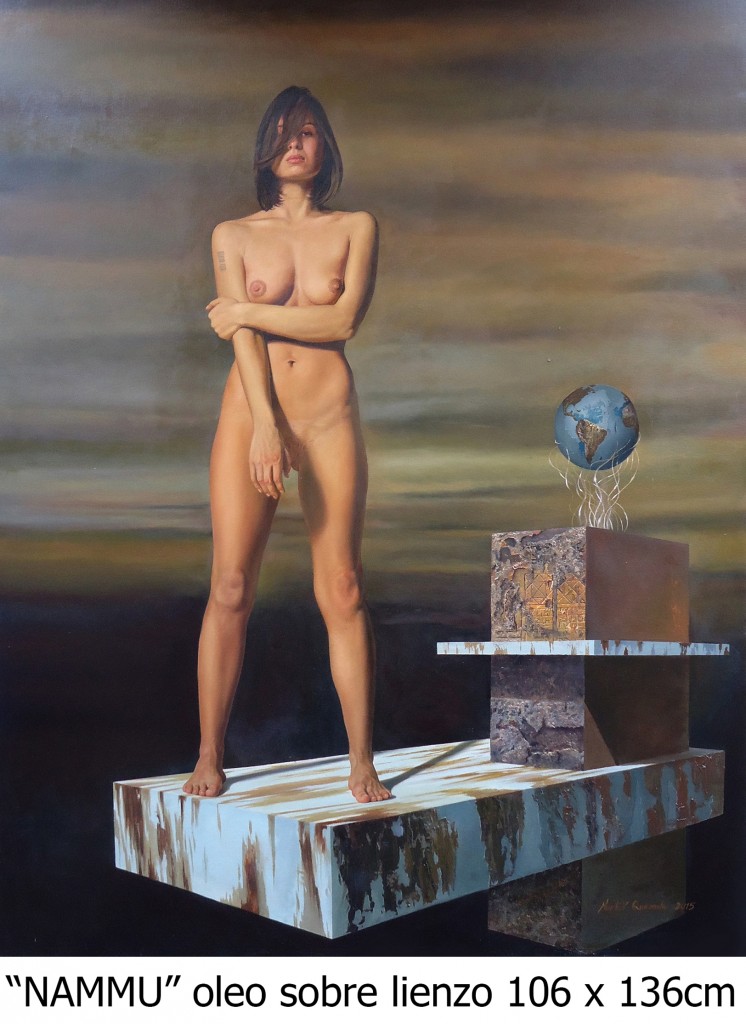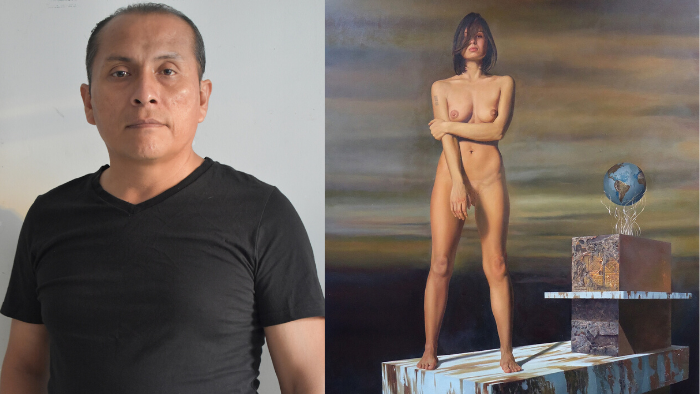“I believe that figurative art tends to communicate more simply the intention of the artist”
*Interview conducted in Spanish, original answers at the bottom*
Artist Neptalí Quezada Alvarado was born in Trujillo, Peru, in 1976. Ever since he was a little boy he was interested in art. After earning his bachelor’s degree to become a Mathematics teacher, he studied Visual Arts at the School of Fine Arts “Macedonio de la Torre” and developed his professional career as an artist.
Quezada’s beautiful oil paintings combine realism and surrealism —many of them with powerful environmental messages— and have been exhibited across Peru and Ecuador in different shows and galleries. He has earned several awards during the past few years, and in 2019 was interviewed for the Peruvian TV show Detrás del Arte.

In this Q&A, artist Neptalí Quezada shares with PoseSpace how he started drawing, which artists have influenced his work, details about the process of making his work and more:
Can you tell us about your background and how you got into art?
From my childhood, what I remember the most during my first years of life (when I was two to three years old) is sitting next to my mother listening to the instructions on how to draw a dummy. She would take my hand and, on other occasions, I would do it alone. Later on, my father, every now and then, bought me sketchbooks—those of cardboard and silk sheets— and watercolor pencils. During this stage of my life, I saw my father draw a lot and quite well; he did it as a hobby since he never studied drawing at school, much less professionally, but I wanted to copy what he created. It was in the first five years of my life that I acquired a taste for drawing and painting.
As a teenager, I made copies of some paintings by famous painters such as Rubens and Velásquez with tempera paint on cardboard, that some people—friends or family— liked and later bought them for me.
Then at the end of my university studies as a teacher of mathematics, I applied for the School of Fine Arts “Macedonio de la Torre” in the city of Trujillo (Peru), and I was awarded the gold medal for the best student in 2003, which was a great incentive to continue with my professional artist projects. Since then, I dedicate myself to art professionally.

Which artists have had an influence on your work?
I should mention that, at first, it was Rubens and Velásquez. Then, as a student of Fine Arts: Caravaggio, Ingres, Bouguereau, and Dalí. And, in recent years I have been investigating Claudio Bravo (Chilean painter).
Can you tell us about the process of making your work?
Well, the first thing is to immediately address the idea that comes to mind before I forget. I have had some of those ideas when I go on the bus to work or in my bed right when I start falling asleep and immediately I stand up to sketch it before I forget.
After the sketch, I use Photoshop to have a clearer idea of the images and textures that I want to achieve at the end of the work. It is here that I look for the image closest to the sketch that I made at the beginning. Finally, when I am satisfied with the digital work I do previously, I transfer it to the canvas.
And, well, it probably looks like a ritual, but I’m always accompanied by a New Age musical background or alternative rock to escape from my surroundings.
What do you think of PoseSpace?
It fascinates me and I use it often.
It is a great resource especially for figurative artists, it has a wide range of models and poses that can fit with your compositional idea of the work you want to portray.
My favorite models are Becca and Vaunt.

Painting by Neptalí Quezada using model Vaunt as a reference (image shared by artist)
What is the importance of figurative art for you?
Art is one of the many ways that men and women have to communicate and, from my point of view, I believe that figurative art tends to communicate more simply the intention of the artist. For example, if the artist is empathic with caring for the environment, even if his work is immersed in surrealism, the images that the viewer recognizes will encourage some reflection on ecological awareness.
Now that you have more experience, what advice would you give your younger self?
Difficult to answer, but I think I would advise myself to devote more time, as much leisure time as possible, to find new forms of visual plastic expression.

Neptalí Quezada’s Facebook: https://www.facebook.com/neptali.quezadaalvarado1
Interview by Andrea Miliani
Spanish version: original answers
El artista Neptalí Quezada Alvarado nació en Trujillo, Perú, en 1976. Desde que era niño se interesó por el arte. Más adelante, después de obtener su licenciatura para convertirse en profesor de Matemáticas, estudió Artes Visuales en la Escuela Superior de Formación Artística “Macedonio de La Torre” y desarrolló su carrera profesional como artista.
Las hermosas pinturas al óleo de Quezada combinan el realismo y surrealismo —muchas de ellas con poderosos mensajes ecológicos— y se han exhibido a lo largo de Perú y Ecuador en diferentes presentaciones y galerías de arte. Este talentoso pintor ha ganado varios premios durante los últimos años y en 2019 fue entrevistado para el programa de televisión peruano “Detrás del Arte”.

En esta serie de preguntas y respuestas el artista Neptalí Quezada comparte con PoseSpace cómo comenzó a dibujar, qué artistas han influido en su trabajo, detalles sobre el proceso de creación de arte y más:
¿Cómo se desarrolló su relación con el arte?
De mi infancia lo que me ha quedado de recuerdo de mis primeros años de vida (entre dos a tres años) es estar sentado al lado de mi madre recibiendo las indicaciones de cómo hacer un monigote, cogiendo ella mi mano y en otras ocasiones haciéndolo solo. Más adelante mi padre, de vez en cuando, me compraba los cuadernos de dibujo, aquellos de hoja de cartulina y otra de seda, además de los lápices de colores para acuarela. Es una etapa en donde vi a mi padre dibujar bastante y muy bien, él lo hacía por hobby dado que nunca habría estudiado dibujo en el colegio ni mucho menos profesionalmente y yo quería copiar lo que él hacía.
Entonces fueron los primeros cinco años de mi vida los que marcaron mi gusto por el dibujo y la pintura.
En mi adolescencia hacía copias de algunas pinturas de famosos pintores como Rubens y Velásquez con témpera sobre cartulina que llegaba a gustar a algunas personas, amigos o familiares, que luego me las compraban.
Luego al término de mis estudios universitarios como docente de matemáticas postulé a la Escuela de Formación Artística “Macedonio de la Torre” de la ciudad de Trujillo, siendo premiado con la medalla de oro al mejor alumno en el año 2003, lo cual fue un gran incentivo para seguir con mis proyectos de artista profesional. Desde aquel entonces me dedico al arte profesionalmente.
¿Qué artistas han tenido una influencia en su trabajo o lo han inspirado?
Debo mencionar que en un principio fueron Rubens y Velásquez. Luego como estudiante de Bellas Artes son Caravaggio, Ingres, Bouguereau y Dalí; y en los últimos años he estado investigando a Claudio Bravo (pintor chileno).
¿Cómo es su proceso de trabajo?
Bueno lo primero es plantear inmediatamente alguna idea que se me venga en mente antes de que me olvide, incluso algunas de esas ideas las he tenido cuando voy en el bus a mi trabajo o en mi cama al empezar a caerme el sueño y de inmediato me levanto a plasmarlo como un esbozo para no olvidarme.
Luego del boceto utilizo el photoshop para tener una idea más clara de las imágenes y las texturas que quiero lograr al finalizar la obra. Es aquí donde busco la imagen más cercana al boceto que plasmo al inicio. Finalmente, cuando ya estoy conforme con el trabajo digital que hago previamente, lo traslado al lienzo.
Y, bueno, probablemente parezca un ritual, pero siempre estoy acompañado de un fondo musical New Age o rock alternativo para escapar de mi entorno.
¿Qué piensa de PoseSpace? ¿Tiene modelos favoritos?
Me fascina y suelo utilizarlo a menudo.
Es un gran recurso sobre todo para artistas figurativos, tiene una amplia gama de modelos y poses que puede encajar con tu idea compositiva de la obra que quieres plasmar.
Y sobre las modelos favoritas para mí son Becca y Vaunt.
¿Cuál es la importancia del arte figurativo para usted?
El arte es una de las muchas formas que el hombre y la mujer tienen de comunicarse y desde mi punto de vista creo que el arte figurativo tiende a comunicar de una forma más simple la intención del artista, por ejemplo, si el artista es empático con el cuidado del medio ambiente, así su trabajo se encuentre inmerso en un surrealismo, las imágenes que el espectador reconoce motivarán en él alguna reflexión sobre conciencia ecológica.
Ahora que tiene más experiencia, ¿qué consejo se daría a usted mismo cuando estaba empezando a interesarse por el dibujo y la pintura?
Difícil de responder, pero creo que me aconsejaría a dedicarme más tiempo, todo el tiempo posible de ocio para poder encontrar nuevas formas de expresión plástica visual.
Neptalí Quezada / Facebook: https://www.facebook.com/neptali.quezadaalvarado1
Entrevista: Andrea Miliani

